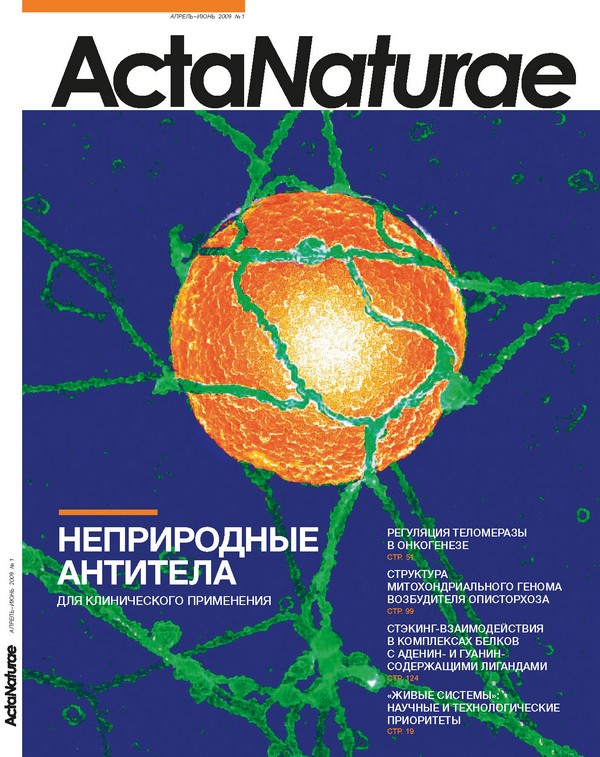The Interaction between the RNA-Dependent RNA-Polymerase of the Hepatitis Virus and RNA Matrices
- Authors: Konduktorov KA1, Lyudva GS1, Ivanov AV1, Tunitskaya VL1, Kochetkov SN1
-
Affiliations:
- Engelhardt Institute of Molecular Biology, Russian Academy of Sciences
- Issue: Vol 1, No 1 (2009)
- Pages: 88-90
- Section: Articles
- URL: https://actanaturae.ru/2075-8251/article/view/10824
- DOI: https://doi.org/10.32607/20758251-2009-1-1-88-90
- ID: 10824
Cite item
Abstract
Full Text
Hepatitis C is one of the most dangerous and widespread viral diseases. Currently, the World Health Organization estimates that about 170 million people are infected with the hepatitis C virus (HCV), the causative agent of infection, in almost every country in the world. The RN A-dependent RN A-polymerase (R-RN AP, virus nonstructural protein) is a key fragment that carries out HCV genome replication. R-RN AP is about 65 kDA in molecular weight and localized on the endoplasmic reticulum membrane of infected hepatic cells by the C-tail α-spiral transmembrane domain (21 a.r.). One characteristic feature of R-RN AP is its ability to catalyze RN A synthesis by both primer-dependent and primer-independent (de novo) mechanisms [1]. In the first case, in the in vitro experiments, the primer-matrix poly(rA)-oligo(rU) duplex is used as the RN A matrix; in the second case, the HCV genome fragments are used. It is suggested that oligomer from several identical R-RN AP molecules takes part in the replication. Moreover, oligomer was discovered to be composed of H502 and E18 amino-acid residues located in the interaction area of protein globules [2]. Earlier, we obtained the E.coli strain (the HCV R-RN AP producer) which allows a highly purified recombinant protein with a cell culture yield of up to 6 mg/l to be created and we developed a procedure for enzyme purification to the homogeneous condition (the data of electrophoresis in the polyacrylamide gel) [3]. The purification procedure included methods similar to those described in the corresponding literature [4]; the kinetic parameters of the primer-dependent reaction determined for the polymerase sample were consistent with the literature data as well [5].About the authors
K A Konduktorov
Engelhardt Institute of Molecular Biology, Russian Academy of Sciencesul. Vavilova 32, Moscow 119991, Russia
G S Lyudva
Engelhardt Institute of Molecular Biology, Russian Academy of Sciencesul. Vavilova 32, Moscow 119991, Russia
A V Ivanov
Engelhardt Institute of Molecular Biology, Russian Academy of Sciencesul. Vavilova 32, Moscow 119991, Russia
V L Tunitskaya
Engelhardt Institute of Molecular Biology, Russian Academy of Sciencesul. Vavilova 32, Moscow 119991, Russia
S N Kochetkov
Engelhardt Institute of Molecular Biology, Russian Academy of Sciences
Email: kochet@eimb.ru
ul. Vavilova 32, Moscow 119991, Russia
References
- Bressanelli S., Tomei L., Roussel A., Incitti I., Vitale R.L., Mathieu M., De Francesco R., Rey F.A. // Proc. Natl. Acad. Sci. USA. 1999. V. 96. P. 13034-13039
- Qin W., Luo H., Nomura T., Hayashi N., Yamashita T., Murakami S. // J Biol Chem. 2002. V.277. №3. Р. 2132-2137.
- Ivanov A.V., Korovina A.N., Tunitskaya V.L., Kostyuk D.A., Rechinsky V.O., Kukhanova M.K., Kochetkov S.N. // Prot. Expr Purif. 2006 V/ 48. № 1. Р. 14-23.
- Hengen P. // Trends Biochem Sci. 1995 Jul;20(7):285-6.
- Zhong, W., Ferrari, E., Lesburg, C.A., Maag, D., Ghosh, S.K., Cameron,C.E., Lau, J.Y., Hong Z. // (2000) J.Virol., 74, P. 9134-9143.
- Bradford M.M. // 1976 May 7; 72:248-54.
- Tunitskaya V.L., Akbarov A.Kh., Luchin S.V., Memelova L.V., Rechinsky V.O., Kochetkov S.N. // Eur J Biochem. 1990. V.191 No 1. Р. 99-103.
- Varfolomeev S.D., Gurevich K.G. Biokinetics, М., Grand, 1998, 720 p.
- Wang Q.M., Hockman M.A., Staschke K., Johnson R.B., Case K.A., Lu J., Parsons S., Zhang F., Rathnachalam R., Kirkegaard K., Colacino J.M. // J Virol. 2002 Apr; 76(8):3865-72.
Supplementary files







